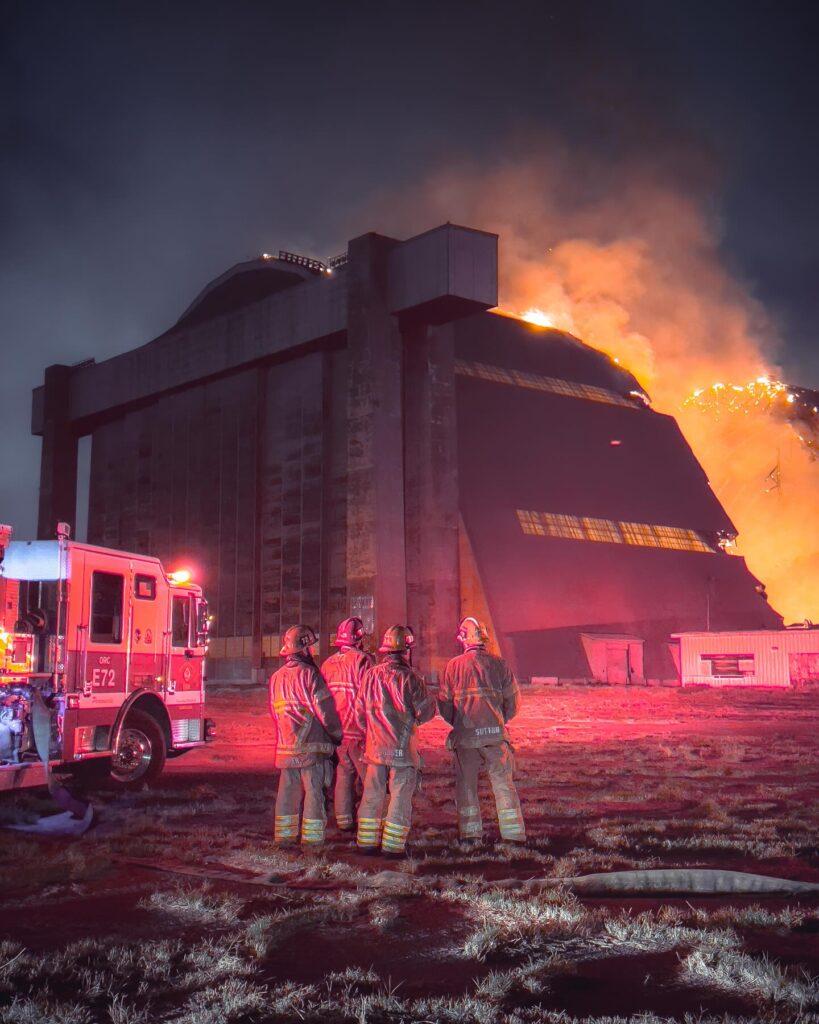
Aircraft Hangar Fires – What Every Hangar Owner/Operator Should Know

The Presence of Flammable Materials
Dangerous and costly aircraft hangar fires and flames can quickly ignite for several main reasons. This includes but is not limited to the presence of highly flammable materials, electrical system malfunctions, or certain mechanical defects. One frequently encountered cause of these blazes is the dreaded fuel spill or leaks that occur during refueling or maintenance. Aircraft and even spacecraft commonly contain considerable amounts of fuel. That said, even small spills of jet or aviation fuel can easily ignite and burst into flames when exposed to sparks, heat, or static electricity.
Complex Electrical Systems
The hangar structures themselves can experience electrical malfunctions that are another potential serious cause of fire hazards. These structures are interlaced with complex electrical systems, including interior lighting, power equipment, and charging stations for aircraft batteries. Short circuits, faulty wiring, or overloaded circuits can immediately trigger a fire, especially when electrical systems are not adequately maintained and routinely inspected. Aircraft hangars are indeed some of the more challenging structures when it comes to designing for effective fire detection, fire protection, and suppression.
The Presence of Open Flames
Human error is also a factor in many hangar-related fires. Workers sometimes inadvertently trigger combustion by mishandling chemicals or flammable materials, failing to store them correctly, or using equipment in the wrong way. Everyone should know by now that smoking or the presence of open flames in a hangar can also quickly ignite a fire. Even aircraft mechanical failures inside a hangar can produce flames. For example, faulty components within an engine, overheated aircraft systems, or a malfunctioning auxiliary power unit or APU can rapidly ignite flames when aircraft are not properly maintained.
What is HFPA 409?
NFPA, or The National Fire Protection Association, sets standards that “help safeguard life and property through requirements for the proper construction and fire protection of aircraft hangars used for aircraft storage, maintenance, or related activities.” NFPA 409 sets the standard throughout the aviation industry regarding fire safety in aircraft storage facilities. Because there are considerable fire risks associated with hangars and aircraft, it is vital to fully grasp the inner workings of the guidelines as set forth by the NFPA.
Fire Suppression Systems
Aircraft storage buildings, commonly called hangars are large structures that have onsite many types of flammable materials. The rules found within the pages of NFPA 409 documentation encompass fire suppression systems, hangar construction, and other related topics. The main objective is to make certain that these structures are safe for personnel and free of fire hazards. One of the core elements of these documented rules is that of how fire suppression systems are installed and what types of systems are used.
Size Matters When It Comes to Hangar Fires
Aircraft hangars are divided into four key groups (I, II, III, and IV) as outlined in the NFPA 409. Hangar size, the type of aircraft to be stored, and the specific planned operations all come into play. Each of the group classifications has unique fire protection and suppression requirements. These are designed to target the specific fire risks inherent to the different types of hangars that are currently in use throughout the country. Below is a breakdown of each group:
Group I Hangars
These hangars are often the biggest in overall size and, as such, demand comprehensive fire protection systems and protocols because of the significant quantities of fuel and other flammable materials they may contain. They must have one of more of the features listed here:
Aircraft access door height is greater than 28 feet
A single fire area that exceeds 40,000 square feet
Are able to hangar an aircraft with a tail height exceeding 28 feet
Group II Hangars
This hangar group is smaller. They must have these following features:
Aircraft access door height is under 28 feet
Have an aircraft bay ranging from 12,000 to 14,000 sq ft.
Group III Hangars
These hangars are defined as having a row or rows of multi-unit hangars, open hangars that house multiple aircraft, or a freestanding unit that has only one aircraft under cover. They must have both of the following features:
An aircraft access door height of under 28 feet
The aircraft storage space is less than 12,000 square feet
Group IV Hangars
This hangar group has an aircraft storage area larger than Group III, which is built with a membrane-covered rigid steel frame. It should be biodegradable, resulting in a smart fire protection solution for transitioning away from Mil Spec AFFF and AR-AFFF foams.
NFPA Primary Fire Protection Requirements
Since aircraft hangars present unique hazards to both people and assets, it is essential to employ the critical fire protection directives as outlined by NFPA 409 documentation. For example, there is the provision for an ignitable liquid drainage floor assembly inside hangars. This allows for the fast and safe removal of liquids that are flammable from floor areas. In addition, there must be a proper automatic sprinkler system installed. Note that each hangar group will have a specific type of sprinkler system that is required. This ensures that adequate fire suppression is provided and is in line with any given hangar size.
Encapsulator Agent Suppression Systems
Equally important is foam suppression systems. These systems are intended to be highly effective in fighting most fire hazards typical of the hangar environment. The good news is that there are many new and innovative fire suppression agents and systems available today. When it comes to areas that are high-hazard environments, foam is a superior choice. Encapsulator Agent Suppression Systems extinguish most aviation fires quickly while minimizing damage to aircraft, the structure, and surrounding equipment. When an indication of fire is detected, these systems spring into action, greatly reducing the spread of flames.
Routine Maintenance and Inspections
The routine inspection and maintenance of hangar fire protection systems is vital to equipment reliability. The NFPA 409 documentation supports this, ensuring that these systems remain continually functional and effective. This includes regular checks of sprinklers, foam deployment systems, fire alarms, and other aviation safety equipment. Understanding and applying these cornerstone requirements guarantees the highest levels of hangar safety over the short and long term. Owners and operators that commit to always placing safety first save lives and protect high-value assets. Creating a comprehensive and fully customized fire safety plan is strongly recommended.
Other Safety Tips
Aviation has historically been dangerous; however, the industry continues to learn from past mistakes. This has resulted in the industry becoming a very safe and reliable environment, especially within the United States. That said, OSHA’s Aviation safety requirements include extensive rules requiring aircraft hangars to be fully OSHA-compliant. For example, hazardous material spills such as oil spills and toxic chemicals must be cleaned up in an acceptable way. Flammable solid and liquid materials must be stored away from any combustible materials. Fire extinguishers are required to be on hand and be easily accessible. If separator curtains are used, they must be fire-resistant.
Personal Protective Equipment
Personal Protective Equipment (PPE) is a vital and necessary tool for aircraft hangar safety. PPE must be donned and worn in situations where the protection of an individual from any hazards is required. Workers should wear clothing that is not easily ignitable or could catch onto moving parts. The use of jumpsuits, gloves, closed-toe shoes, and similar precautions will greatly improve overall hangar safety. Finally, here is an interesting hangar fire suppression video found on YouTube that shows clearly how modern technology and systems are making hangars around the country safer every day.
In light of recent events regarding the Los Angeles Fires and the devastation caused, please consider the Los Angeles Fire Relief Fund.
